Sourdough Glossary: 55 Sourdough Bread Terms Explained
This post may contain affiliate links.
Sourdough glossary with 55 sourdough bread terms explained with full color photos. Your ultimate guide to sourdough bread terminology.
Have you come across sourdough bread terms and not understood them?Never fear! Here is the ultimate list of 55 sourdough bread terms explained!
This sourdough glossary pairs with my Beginner's Guide To Baking Simple Sourdough Bread.
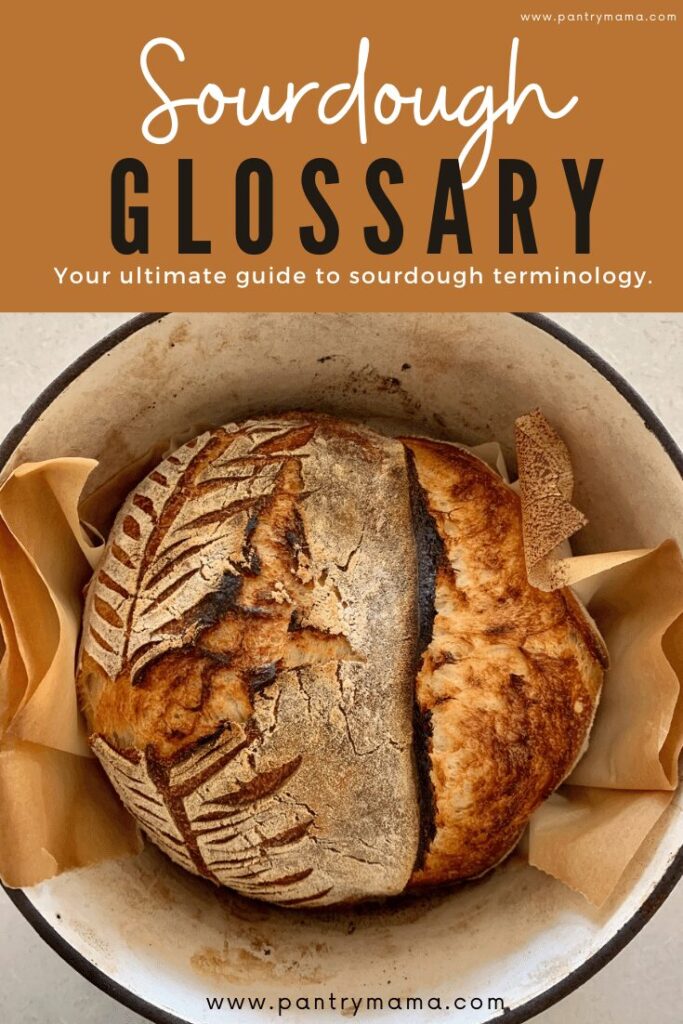
Sourdough Glossary
ACETIC ACID
Acetic acid refers to a type of acid produced by the bacteria in your sourdough starter. Acetic acid is responsible for making your starter more sour and giving it it's characteristic tangy flavor.
You can read more about acetic acid and how to make your sourdough more sour here.
ACTIVATION
Activation can refer to activating a dried starter that has been either gifted, purchased or just stored for later use.
It can also refer to feeding your sourdough starter in order to "activate" it ready for baking.
ALIQUOT JAR
In sourdough terminology, an aliquot jar refers to a small jar that holds a sample of dough, taken from the larger mass of dough. This small sample of dough is placed in the bowl with the rest of the dough and allows the baker to measure bulk fermentation more accurately. You can read more about how and when to use an aliquot jar for sourdough baking here.
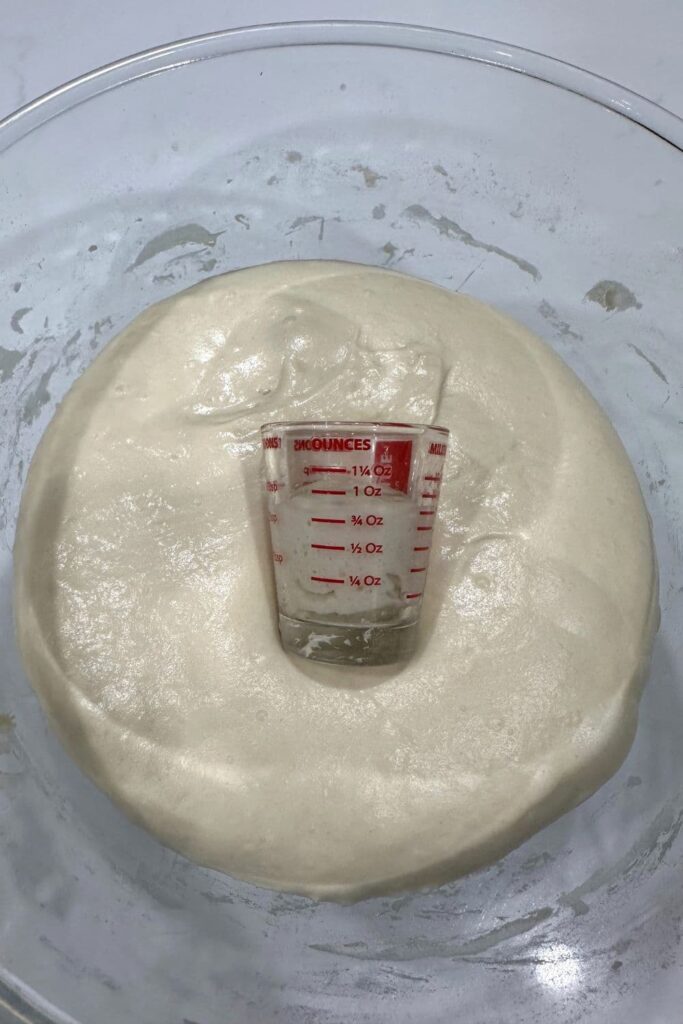
ALVEOLI
Alveoli is a bread term that refers to the gas bubbles or pockets in the crumb of your bread. Many sourdough bakers strive for large alveoli in their bread, however this is not always the case. Large alveoli can be achieved by getting the right combination of fermentation, time and temperature.
I've written a full guide to getting better sourdough alveoli here.
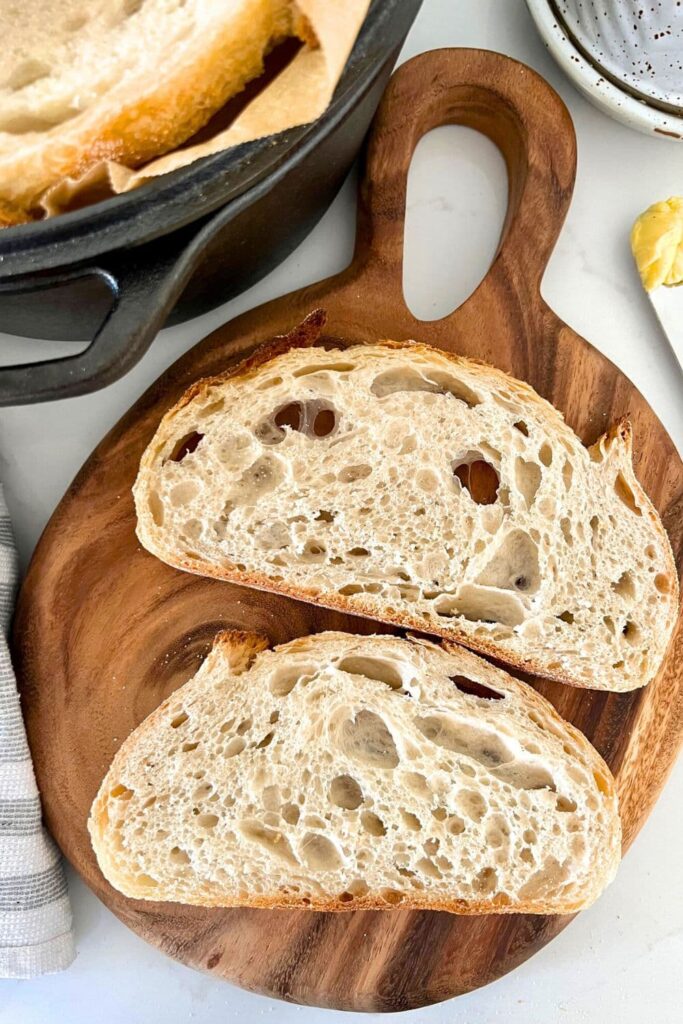
AMYLASES
Amylases is an enzyme that converts starches to sugar. You will hear it talked about in relation to flour. The amylases convert the starches in flour to sugar to feed the yeast in your sourdough starter.
AUTOLYSE
This can also be referred to as the premix or fermentalyse.
Traditionally, autolyse refers to the mixing (and then resting) of the flour and water - without the sourdough starter.
However, many recipes (including mine) use the term for mixing and allowing the flour to absorb the water. It's the first step in mixing the dough for a sourdough loaf.
You'll find a full guide to autolyse & fermentolyse here.
BAKER'S PERCENTAGES
Baker's percentages are a little different to the percentages you might be used to. When talking about baker's percentages, flour is always 100% and all other ingredients are a percentage of that.
Baker's percentages make scaling a recipe up or down very easy and is why it's generally recommended to use a scale when baking. Weight can easily be scaled using baker's percentages, unlike volume measurements.
You can read more about baker's percentages and using baker's math in sourdough baking here.
BAKING TIMELINE
Baking timeline refers to the schedule you follow as you prepare and bake sourdough bread.
Because sourdough relies on wild yeasts and natural fermentation, the baking timeline or schedule is a lot longer than yeasted breads.
You can learn more about creating baking timelines here.
BANNETON
A banneton is basically a shaping container used to ensure the dough retains it's shape during the cold retard.
Bannetons are made from rattan or cane and need to be floured to ensure the dough does not stick. Rice flour is best for this because it's gluten free.
You'll find a banneton sizing guide here and a guide to preparing, using, maintaining and storing them here.
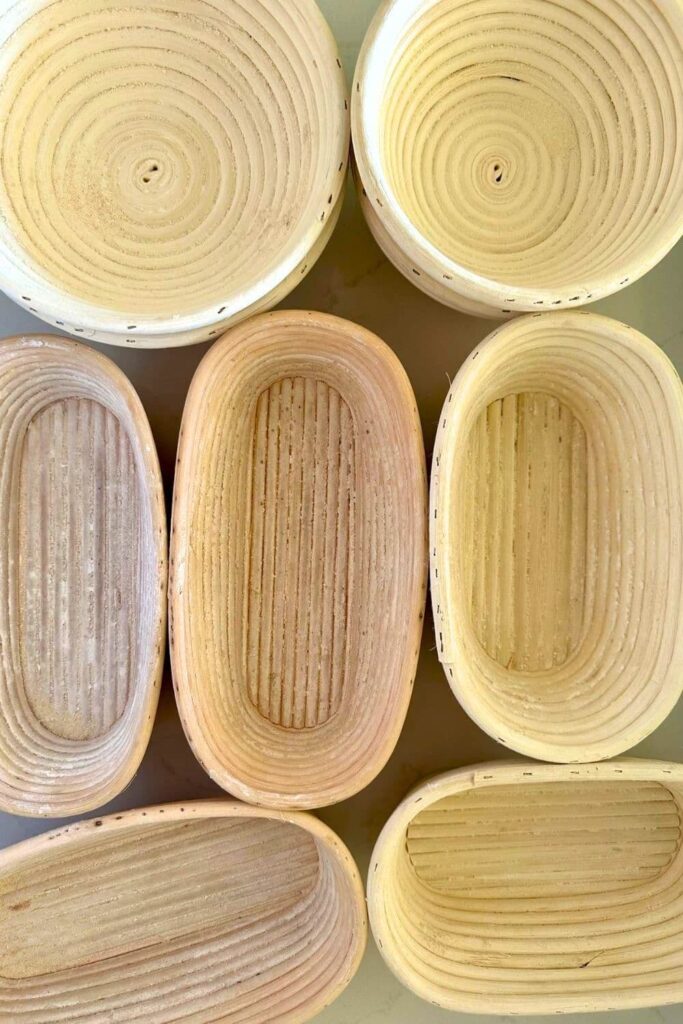
BATARD
Batard is a French word for an elongated or oval shaped loaf of bread. Different to a baguette, a batard is usually wider and shorter. You can see how to shape a batard here.
BELLY
The belly of a loaf of bread is the rounded surface that opens up during baking. You generally want a large belly as this signifies superior oven spring. A good belly is usually present alongside a sourdough ear.
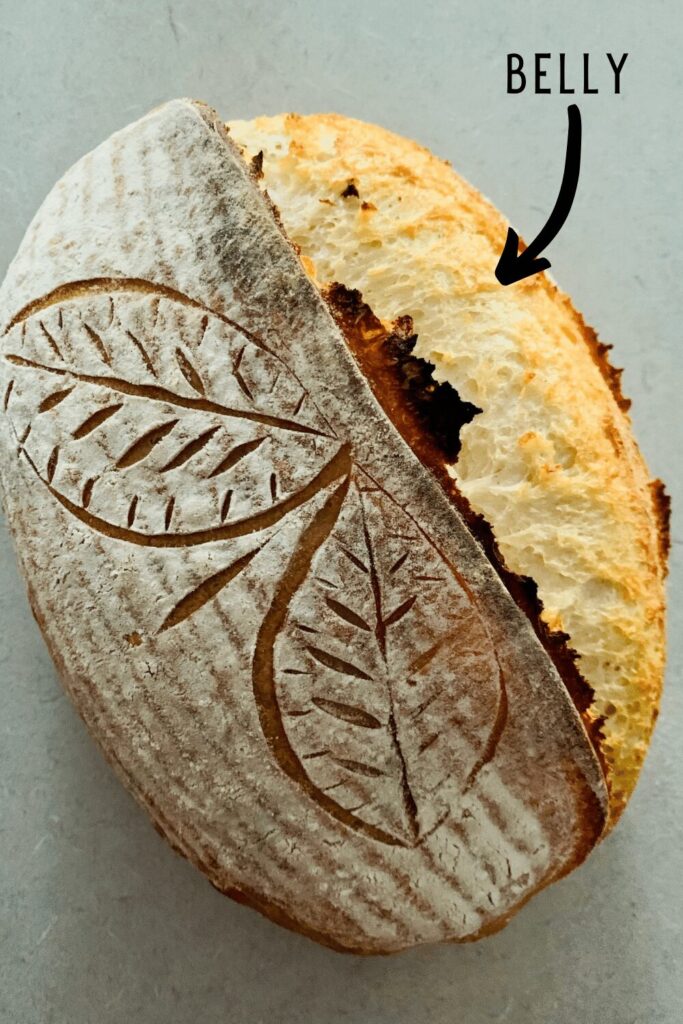
BENCH REST
Bench rest refers to allowing the dough to rest and the gluten to relax. Dough is usually laid directly onto the kitchen counter or "bench" for this. Dough can have bench rest after pre shaping for example. The dough relaxes and is then ready for shaping.
Bench rest can also refer to dough that has been shaped, but is not going to be cold proofed. Bench rest can be used instead of "proofing".
BIGA
Biga isn't really a sourdough term, however you will hear it mentioned from time to time. Biga refers to a portion of pre fermented dough made with commercial yeast.
It has origins in Italy and is often used for Cibatta in order to add a depth of flavor (similar to that of a sourdough starter).
BLISTERS
Sourdough blisters refer to the blistering on the crust of sourdough bread. It's often associated with the San Francisco style of sourdough and comes from a long cold fermentation.
There's a full guide on how to get blisters on sourdough bread here.
BOULE
Boule is a French word for a round loaf shape. It is one of the most common loaf shapes for baking sourdough. You can see how to shape a boule here.
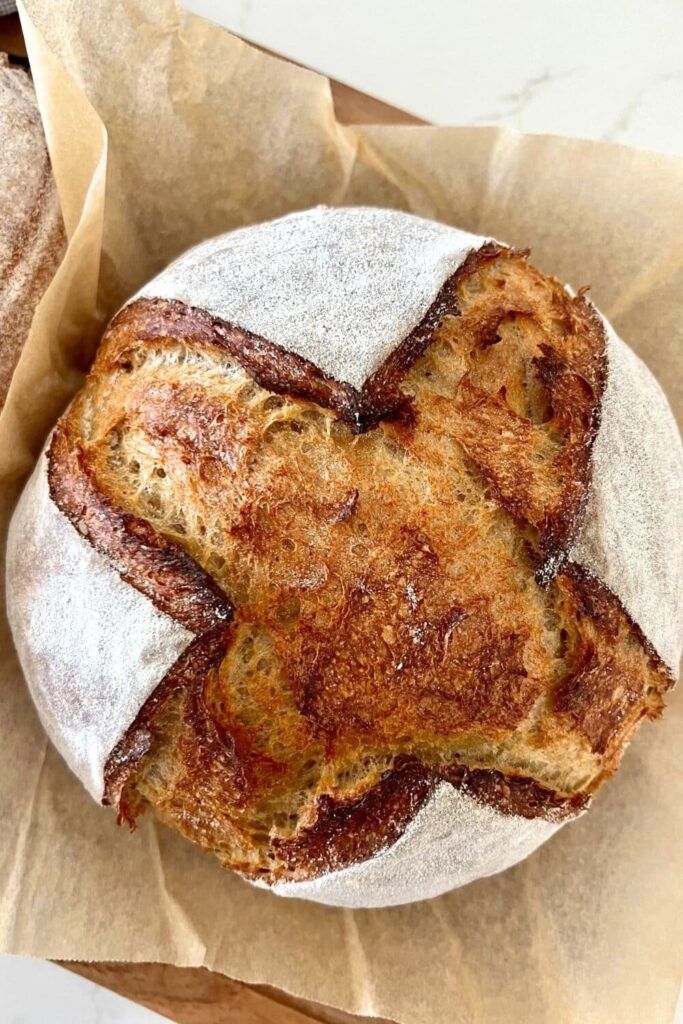
BULK FERMENT
This is the part in the sourdough process where all the magic happens. It's where your dough does majority of it's fermentation.
It's called bulk fermentation because the dough ferments as one "bulk" mass before being divided and shaped.
It is sometimes referred to as the "first rise".
This is the part of the process that can make or break your loaf. Too short and your bread will be under fermented. Too long and your dough will be over fermented.
Bulk fermentation is complete when the dough has just doubled, is domed on the top and is light and pillowy. You'll see bubbles formed underneath the dough.
You can read more about the bulk ferment and how it's done in my beginner's guide to baking simple sourdough or here in my round up on bulk fermentation vs cold fermentation.
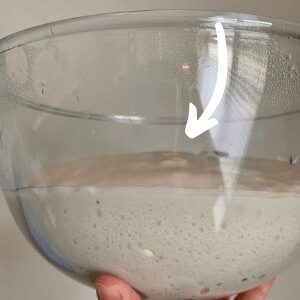
CAMBRO CONTAINER
A straight sided, plastic container with a tight fitting lid that is often used in professional restaurants. It is used in sourdough baking for accurate bulk fermentation because the straight sides allow you to see when the dough has doubled more easily. You can see how to use a Cambro Container for sourdough baking here.
COIL FOLDS
This is another method of strengthening the dough and developing the gluten network.
Coil folds require you to put your hands under the middle of the dough and stretch it upwards and then flap it over itself.
It's regarded as quite a gentle way to handle the dough, while still developing gluten.
Check out this full guide on coil folds for sourdough.
COLD RETARD
This is often referred to as the second rise, cold ferment, cold proof or cold retard.
It happens after the bread has been shaped and placed into the banneton or shaping container.
Even though it is sometimes referred to as the second rise, it's not actually meant to rise your dough. It is a "retard" meaning it slows the fermentation process. The yeasts are not very active at low temperatures, however the bacteria that develop the flavor of the bread are still active.
The cold retard can be used to develop the sourness of your bread. It can also be used to manipulate the timing of your bake. You can read more about the cold retard here.
COUCHE
Couche refers to a piece of heavy linen fabric used to support shaped loaves in their final proofing. It is most often used for baguettes.
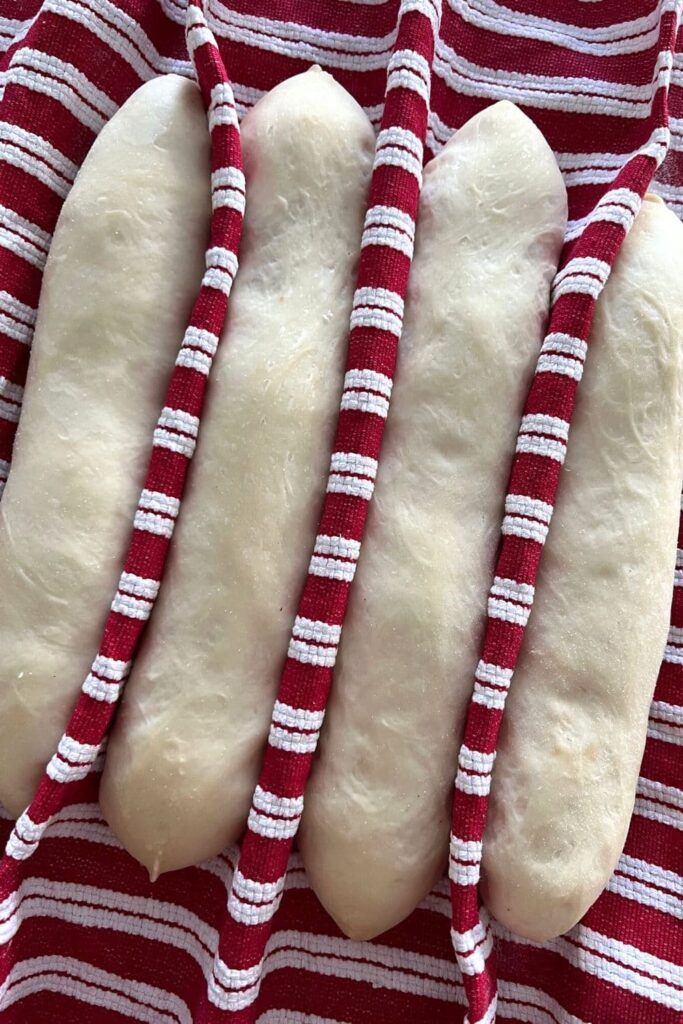
CRUMB
Crumb this refers to the inside of the bread and the texture that it has when you cut it open. You’ll hear people refer to it as open crumb or tight or closed crumb.
Open crumb is much sought after, however a more closed crumb can be just as tasty (and the butter doesn't run through haha). You can see what sourdough bread should look like here. See also alveoli.
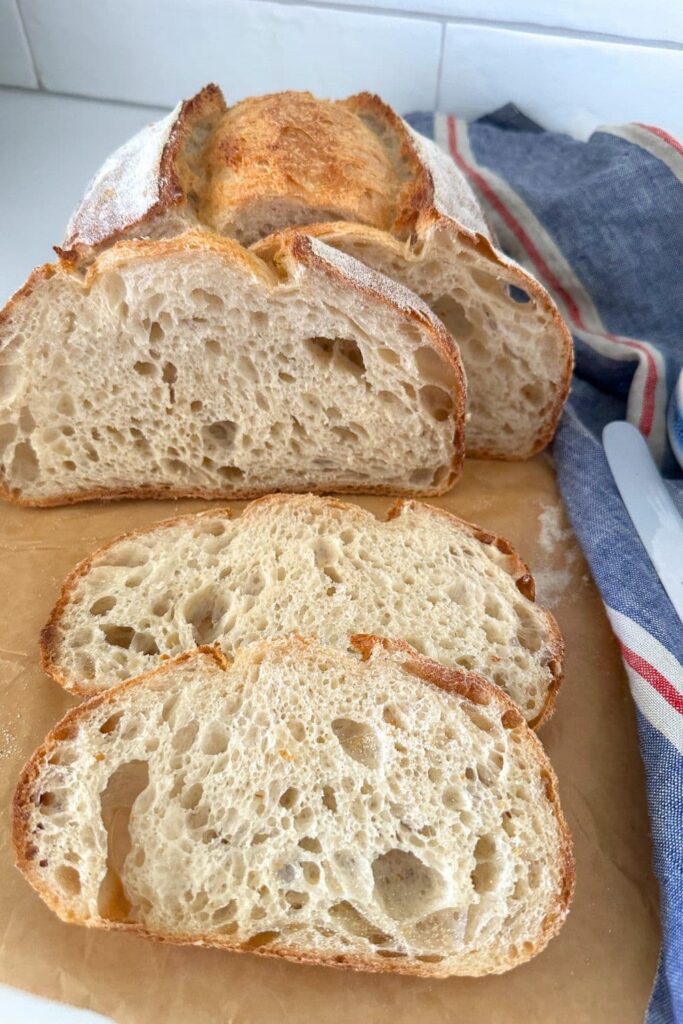
CRUMB SHOT
The crumb shot refers to a photo of a cross section of sourdough bread. Many people share crumb shots to show off their crumb (particularly if they've achieved a lacy or open crumb).
Crumb shots are also shared for troubleshooting and analysis to solve any issues that the baker has with their bread so they can improve for next time.
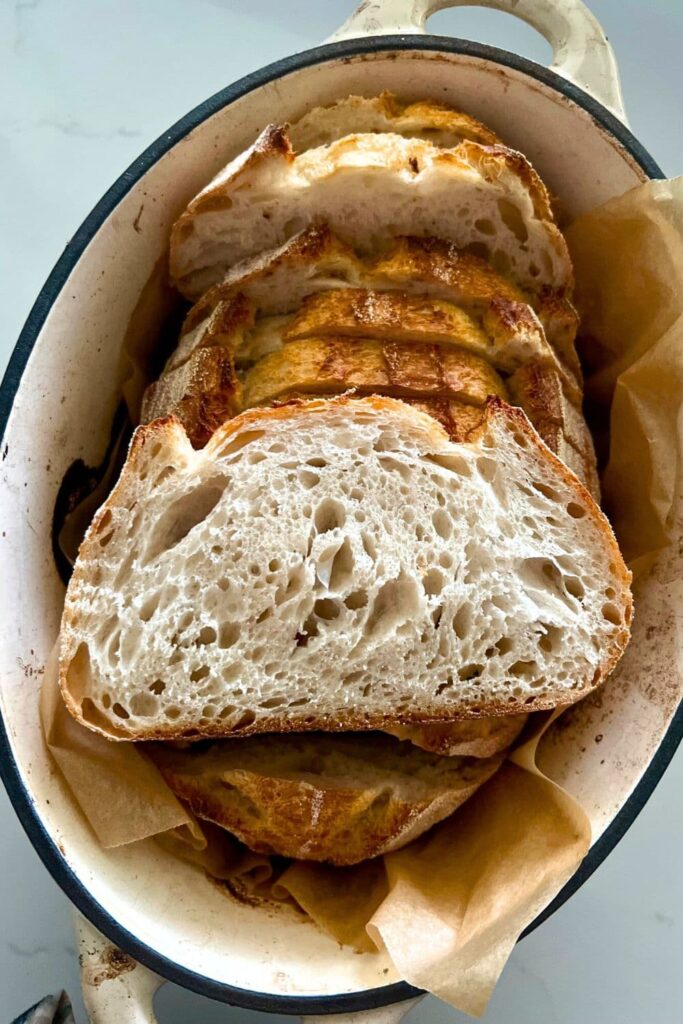
DANISH WHISK
A Danish whisk or dough whisk is specifically designed for mixing dough and can be very handy for the initial mix of sourdough - prior to autolyse.
Dough whisks have either a wooden handle or stainless steel handle. You'll find a great quality Danish Whisk here.
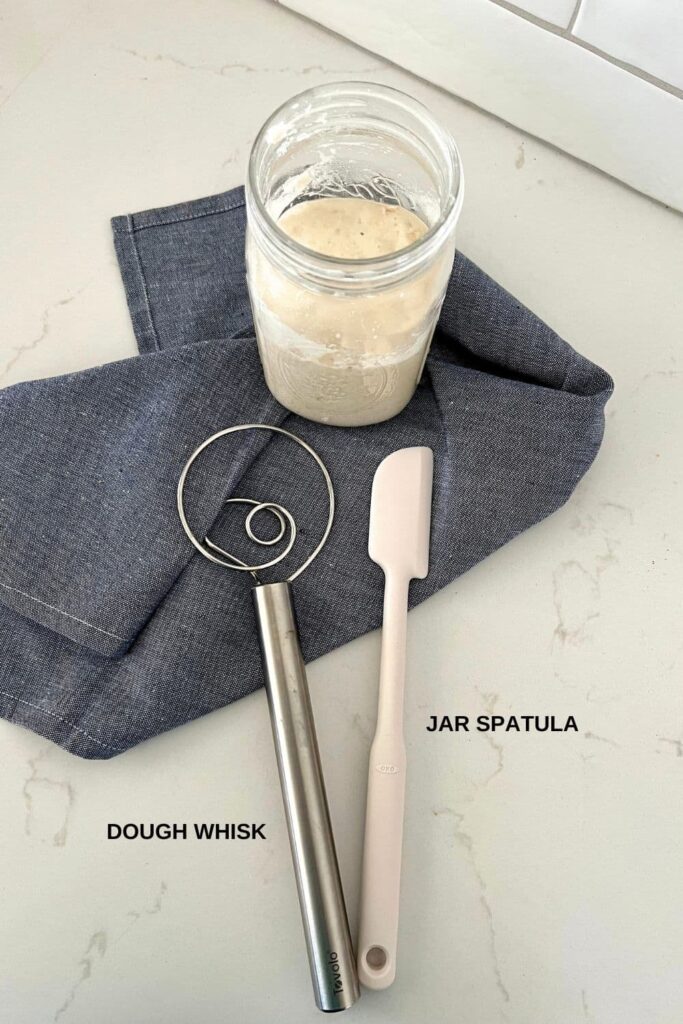
DEGAS
To degas means to push all the air and gas bubbles out, flattening the dough. Degassing is a process associated with sandwich breads - but you don't want to degas traditional sourdough bread as you will lose the beautiful open crumb.
This sourdough sandwich bread uses a degassing process.
DIATASTIC MALT POWDER
Diatastic malt powder is produced by sprouting barley, letting it dry and grinding it up. This powder can then be used in baking bread.
Adding a small amount to the dough will assist in give you better oven spring and a deeper, darker crust. Enzymes in diastatic malt convert starch in flour into sugars to feed the yeast, giving you better rise and a browner crust.
DISCARD
Discard refers to the process of removing a portion of unfed starter from the jar before you feed your sourdough starter.
The portion that is removed is then referred to as "discard". You can read a comprehensive guide to discard here, as well as read about the difference between sourdough starter and sourdough discard here.
DUTCH OVEN
A vessel in which to cook sourdough. Dutch ovens are generally heavy based, cast iron pots with lids.
Dutch ovens can be used to cook a variety of foods but they have become popular for sourdough baking because of their ability to trap steam and giving the bread superior oven spring.
If you'd like to know more about how a Dutch Oven works and whether it's a worthwhile investment for your kitchen, you'll find more detailed information here.
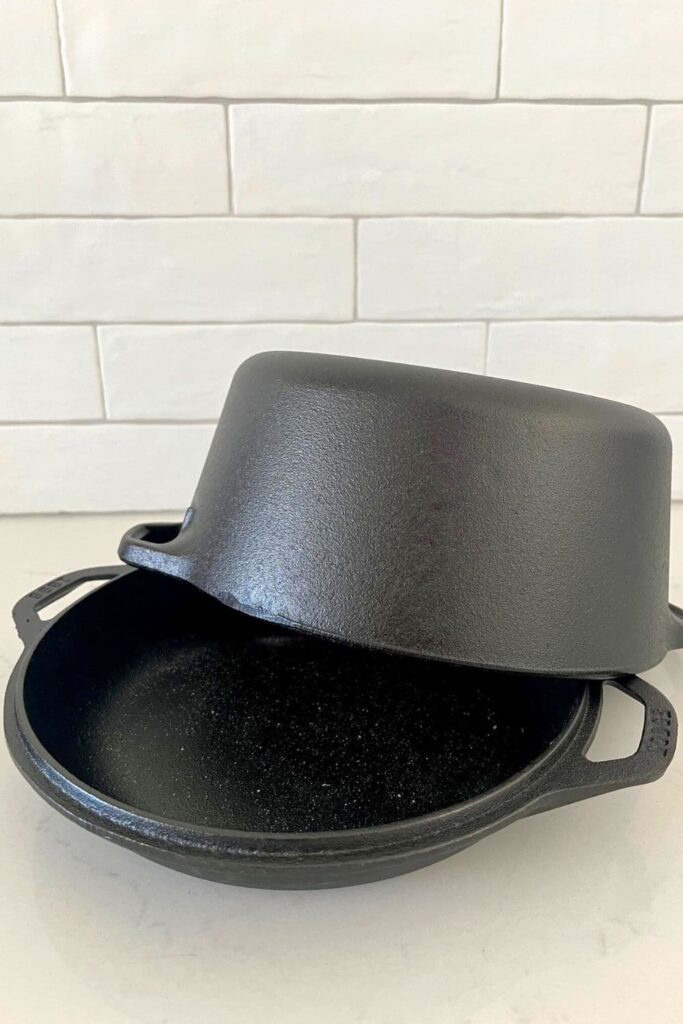
EAR
A sourdough ear is the flap of crust that lifts up during baking. It has become very sought after in recent times, however it has no real bearing on taste or success of the loaf.
You will also hear people refer to "bread bunnies" in relation to the sourdough ear because when the bread is cut it, the slices look like little rabbits with ears.
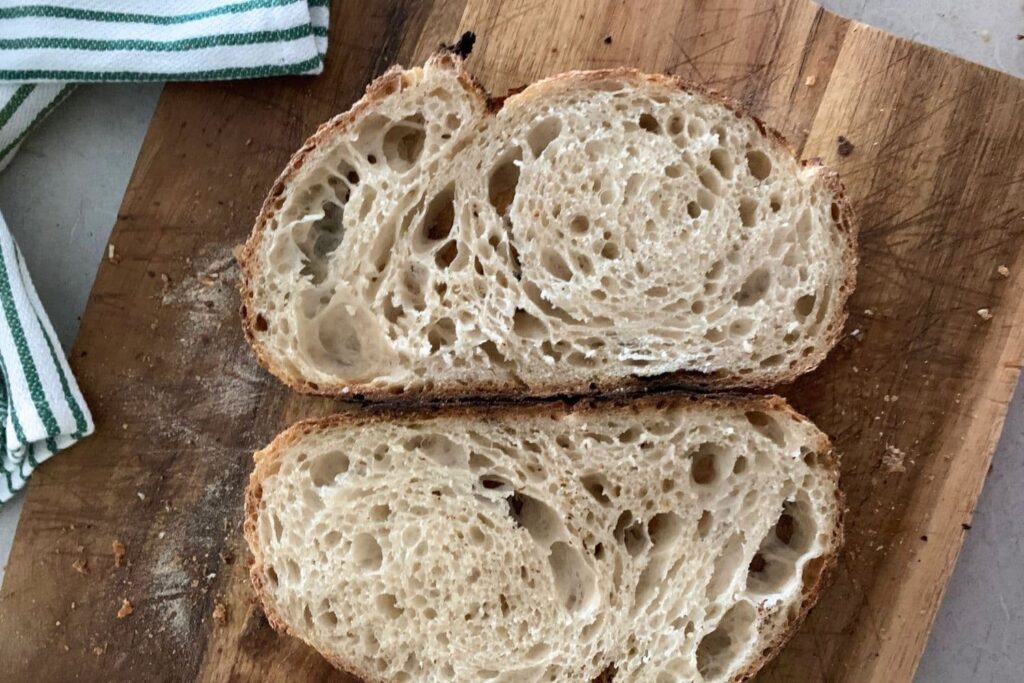
A sourdough ear does generally signify good oven spring, however it is possible to have oven spring without an ear.
You can read more about how to get a sourdough ear on your loaves here.
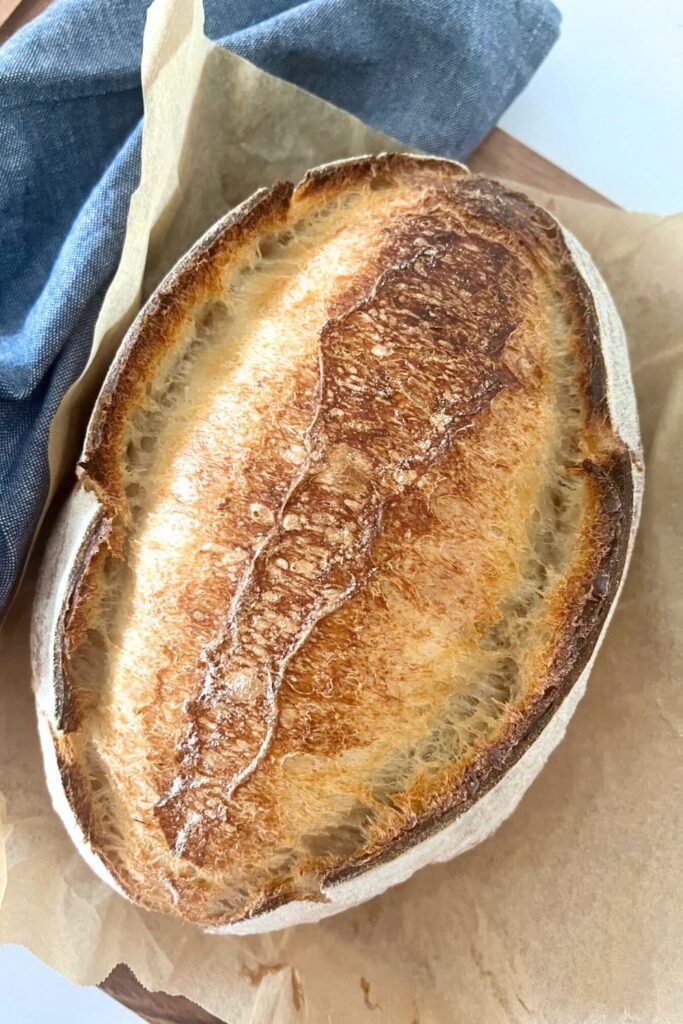
ELASTICITY / EXTENSIBILITY
Elasticity and extensibility refer to the stretchiness of the dough. Sourdough is generally a very elastic dough and should be quite extensible while stretching and folding.
Its elastic qualities come from the gluten networks which are developed throughout the folding process.
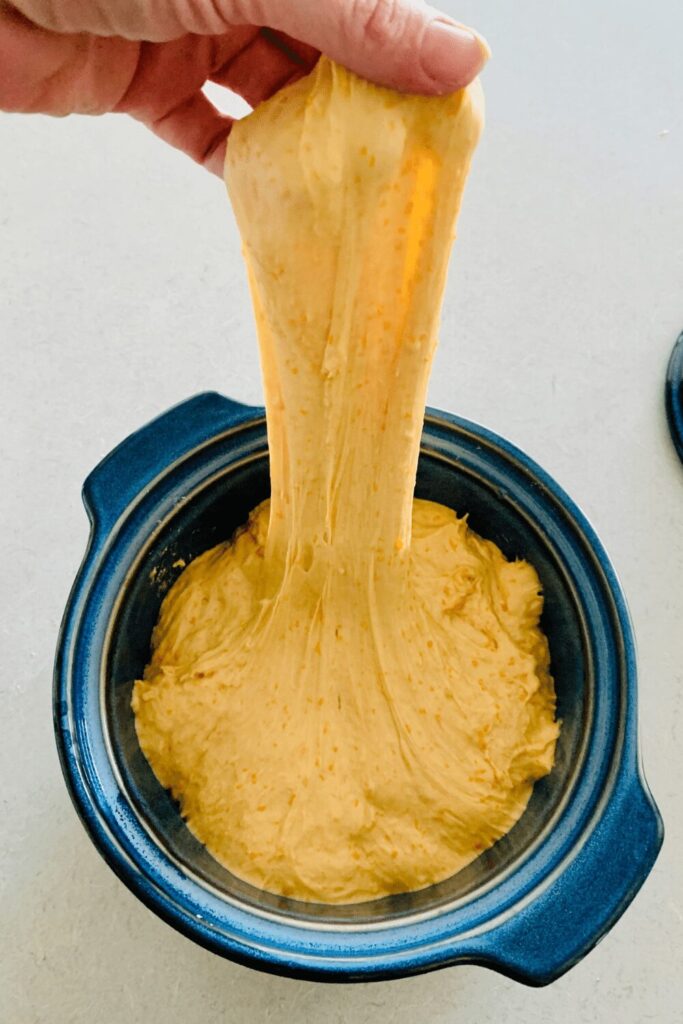
ENRICHED DOUGH
Enriched dough refers to sourdough that has been enriched with fats and oils. Milk, butter, olive oil, sugar and egg are usually used to enrich dough. Doughs that have been enriched with eggs and butter are usually more yellow in appearance.
These Sourdough Hawaiian Bread Rolls are examples of enriched dough.
FERMENTALYSE
Fermentalyse refers to a type of autolyse that includes both the starter and the salt (as in my basic recipe).
Rather than prolonging the autolyse, it is common practice to add flour, water, salt and starter together.
FLOAT TEST
The float test is performed by putting a teaspoon of sourdough starter into a glass of water.
If it floats it's said that it's ready to bake bread with. If it sinks, you need to work on building your starter a little longer.
There is much controversy over whether this test is accurate because you need to perform the test at the right time in your starter's rise cycle for it to be accurate.
You can read more about the float test here.
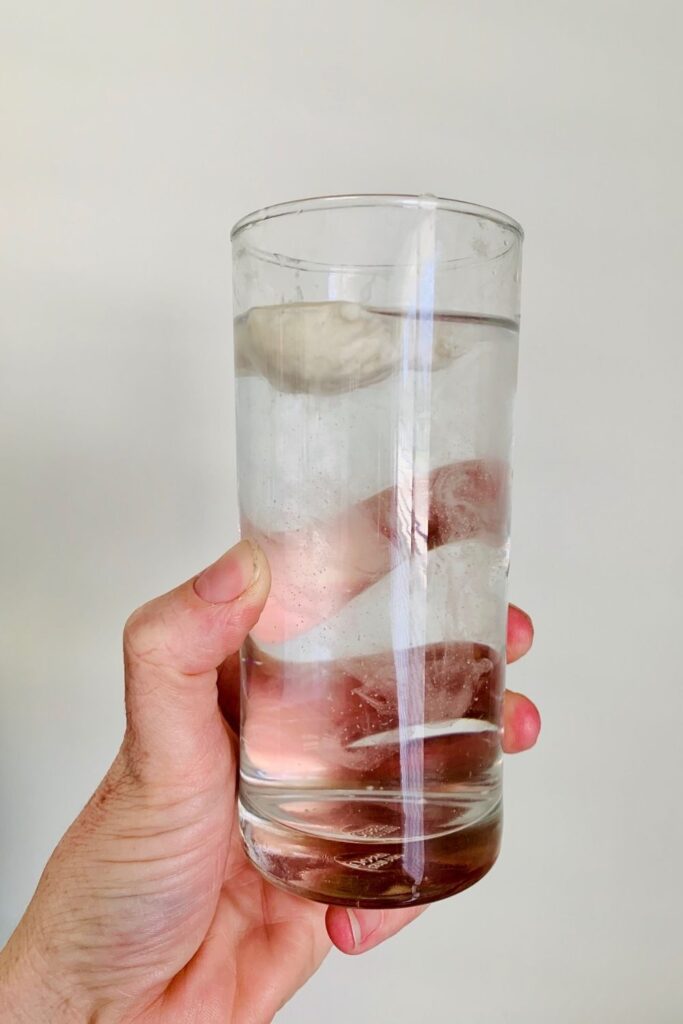
GLUTEN
Gluten occurs as a result of two proteins found in grains like wheat.
Gluten is what gives bread its elasticity and the network of gluten allows your dough to trap the carbon dioxide that the yeast produces.
It's this gas, held inside the gluten network, that causes your bread to rise.
You can find out more about developing gluten in sourdough here.
HOOCH
Hooch refers to the liquid which can form on the top of a hungry sourdough starter. It can form on top of, underneath or even in the middle of your starter.
It's relatively harmless and is the result of the bacteria and yeast eating all of their food and excreting waste. It will smell like alcohol or even nail polish remover.
You can read more about hooch here.
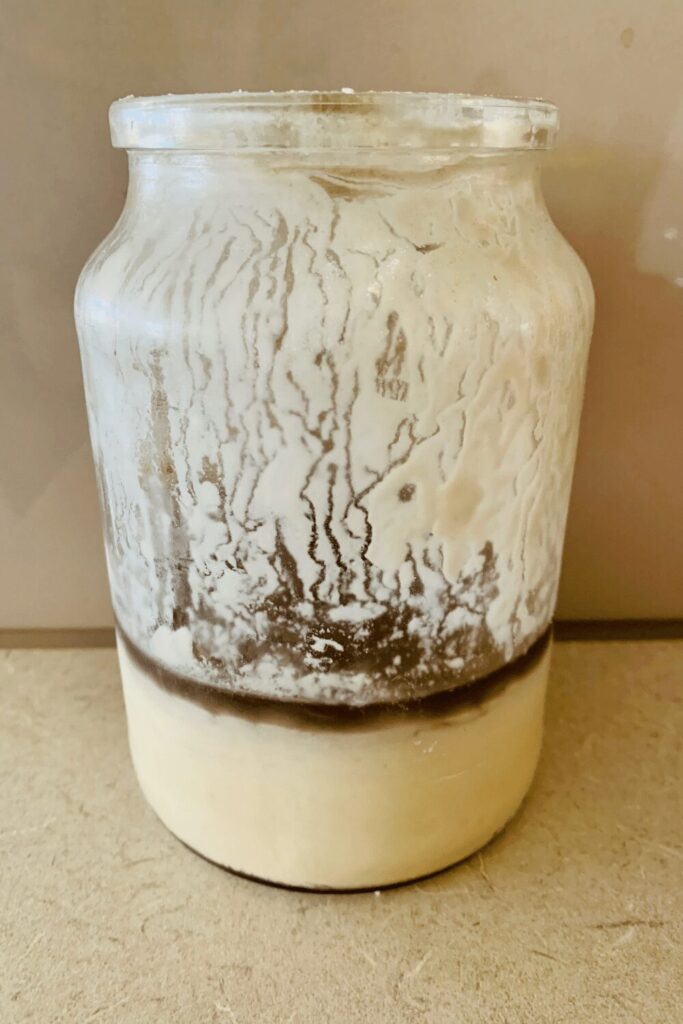
HYDRATION
Hydration refers to the amount of water in your dough or how hydrated it is.
You can work out the hydration of a loaf by dividing the amount of water by the amount of flour then multiplying by 100. This will give you the percentage of hydration.
Lower hydration doughs tend to be easier to work with (around 50 - 70%). Anything above 80% is considered high hydration and can be more difficult - but not always.
You'll find more information on sourdough hydration here and baker's math here.
KAHM YEAST
Kahm yeast is a harmless yeast which can develop on the surface of your sourdough starter. It's not ideal but can be scraped off the top.
You can read more about kahm yeast here.
LACTIC ACID
Lactic acid is an organic acid produced by the bacteria in your sourdough starter. Lactic acid is responsible for lowering the PH of your sourdough starter and keeping the bad bacteria at bay.
LAME
Lame is a french word referring to the piece of equipment you use to score sourdough with. Specifically, the lame refers to the "handle" that the razor blade is placed into. You can purchase a basic lame, like this one for around $10. You can also find decorative lames like this one which are also popular.
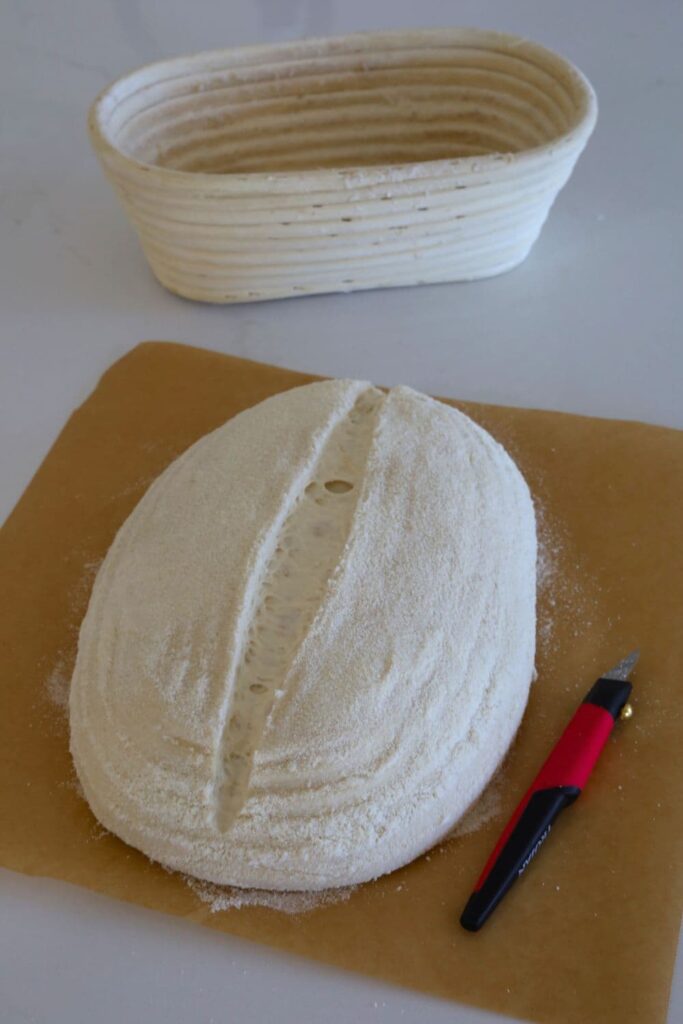
LAMINATION
This process refers to stretching the dough out into a thin sheet on a wet counter before folding it up again.
It is performed to create layers in the dough. Lamination is often used to add flavors to sourdough and in baking croissants. Lamination is performed during the bulk fermentation.
It's generally considered a more advanced technique because you have to stretch the dough out without tearing it, so it must have optimal gluten development.
You'll find a full guide on how to laminate sourdough here.
Lamination is generally easier with a higher hydration dough.
LEVAIN
Often levain is used interchangably with sourdough starter, however a levain is generally an offshoot of your starter.
You take out some of your starter and "build" your levain for a specific recipe.
Not all recipes use levains, however you will come across this term quite often when researching sourdough bread. Can also be referred to as leaven.
You can read a full guide to the differences between a levain and a sourdough starter here.
You can read about scaling your starter here.
MAILLARD REACTION
Maillard reaction is a bread term which refers to a chemical reaction between amino acids and reducing sugars. It gives browned food it's distinctive flavor.
The Maillard reaction gives bread its distinctive brown color when it's baked. It's the same reaction that makes bread golden brown when it's toasted.
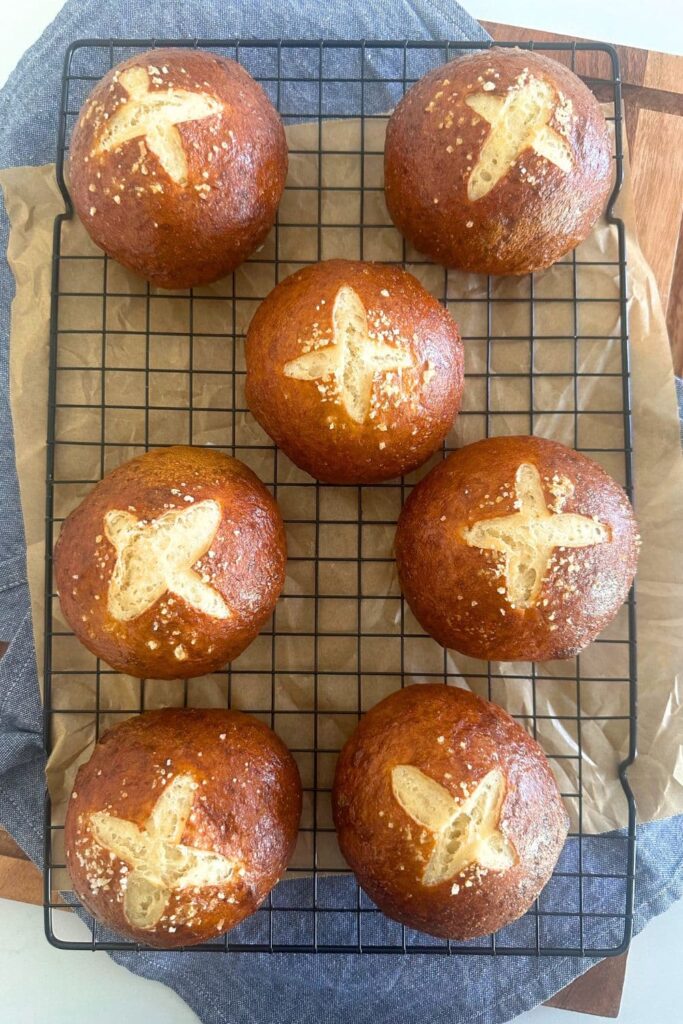
MOTHER
This usually refers to your sourdough starter. It indicates the "original sourdough starter" from which a levain or leaven is made. A sourdough mother is used to create offshoots (called levains or builds) that are used to rise sourdough bread.
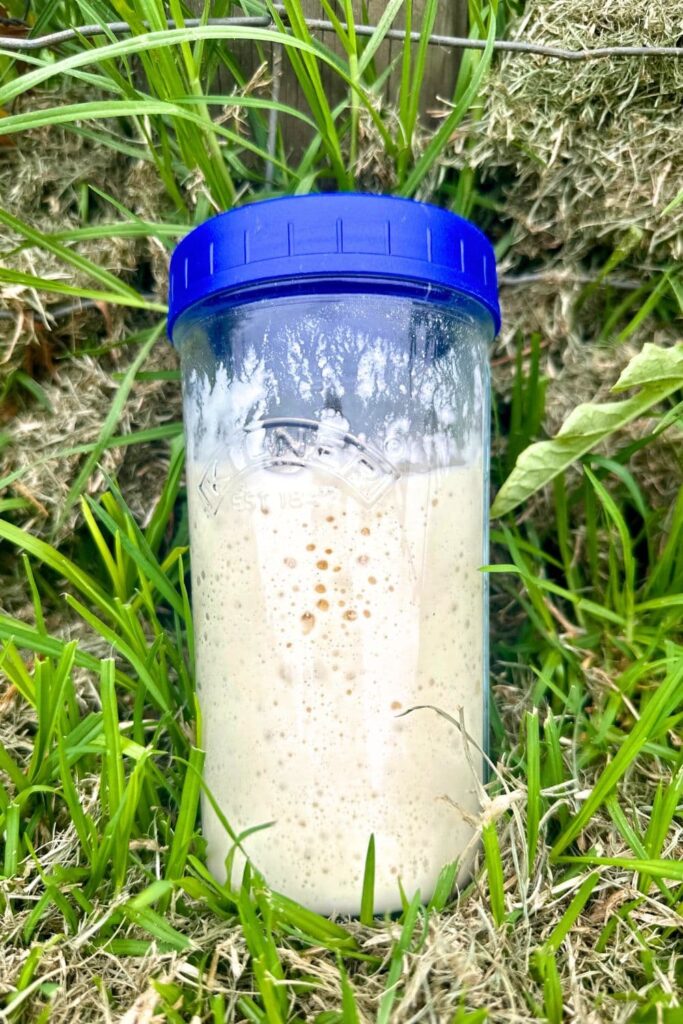
OVEN SPRING
Oven Spring is the goal when you bake - for your loaf of sourdough to burst up, to bloom in the oven and give you that gorgeous puffiness.
Oven spring can only occur if the yeast in your dough still have a bit of energy left. It’s quite a skill to ensure your loaf of sourdough has the perfect bloom when it hits the oven..
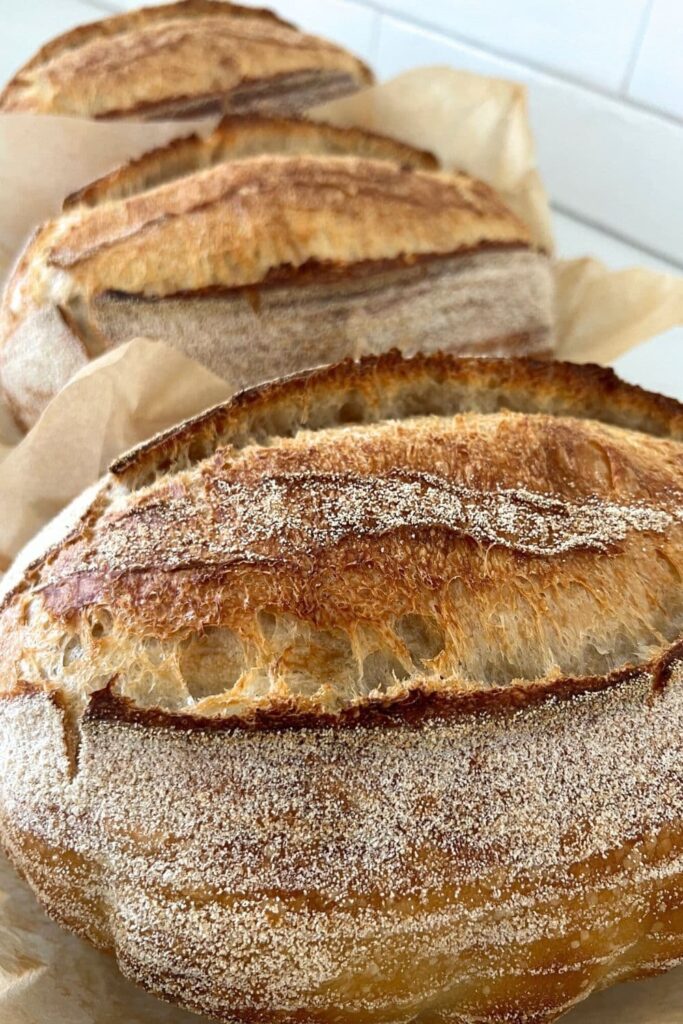
PEEL
A baking peel refers to a wooden board used by bakers to transfer loaves to and from the oven. It can also be referred to as a baker's peel or transfer peel.
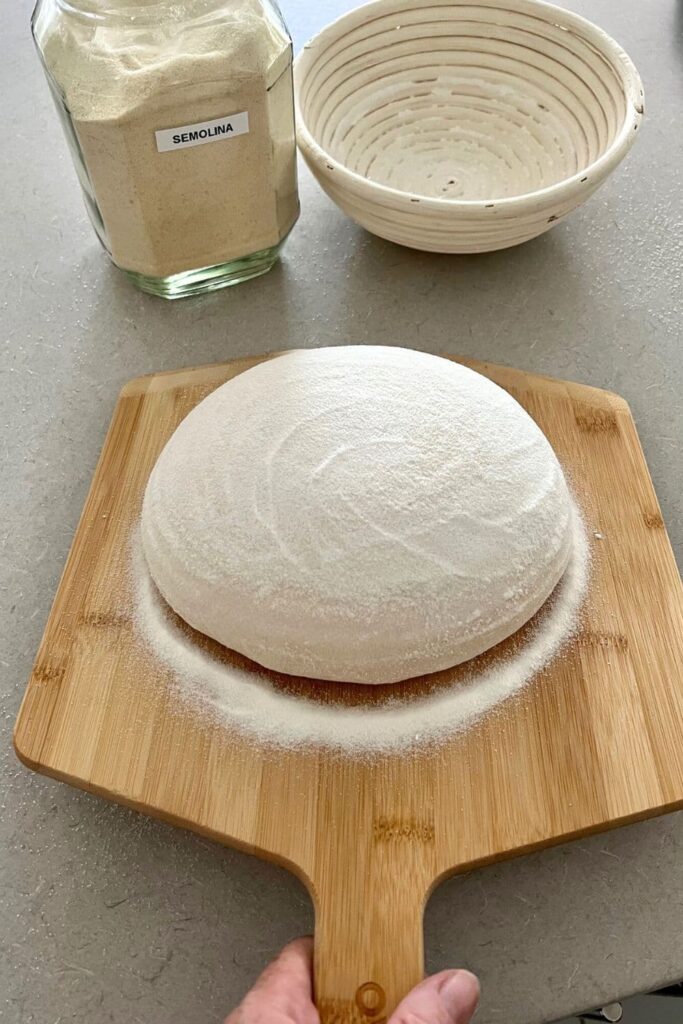
PHYTIC ACID
Phytic acid is an acid contained in the endosperm of grains which reduces the availability of some minerals when we eat the wheat.
The lactic bacteria in sourdough breaks down this phytic acid, making these minerals more bioavailable. This increases the nutritive value of the wheat, making sourdough bread more nutritious for us.
POKE TEST
This test refers to testing whether your bread has fermented sufficiently and is ready to bake. Basically you follow the rules below:
Under proofed - you push your finger on the dough and it springs back very quickly, filling the indent.
Over proofed - you push your finger on the dough and it leaves an indent that does not fill back up.
Perfectly Proofed - you push your finger on the dough and it leaves an indent that slowly starts to fill back in, but not fully.
As you develop your "sourdough instincts" you'll start to get a feel for the dough and when it's ready to go!
PRE FERMENT
A pre ferment is a portion of dough that is made hours before so that it can ferment. The pre ferment is then added to the dough. It adds a deeper flavor.
Preferments can be made using sourdough starter, levain or commercial yeast.
It can get confusing as this is also referred to as a levain or leaven. Sourdough starters and levains are both examples of preferments.
PROOFING
Proofing is often used interchangeably with fermenting however they do not mean the same thing. Proofing refers to the "second" period of fermentation after shaping the dough.
You can cold proof (see cold retard below) or you can proof at room temp (this is a much shorter process than the cold proof).
Because bulk fermentation and proofing are different - sourdough can be well fermented but under proofed. Clear as mud, right?
RATIO
A sourdough starter ratio refers to the proportions of flour and water you feed your sourdough starter. It's a simple calculation used by home bakers and professional bakers alike to measure the amount of flour and water they put in their sourdough starter jar in comparison to the amount of sourdough starter.
You can read the full guide to understanding sourdough starter ratios here.
RESTING
Generally refers to letting the dough rest between folding or shaping.
Resting the dough allows the gluten to relax and makes it much easier to work with.
For example, you let the dough rest between sets of stretches and folds. If you are doing a pre shape, you'll let the dough rest before moving into final shaping.
RUSTIC SOURDOUGH BREAD
Rustic sourdough bread is a no knead, no fuss recipe that focuses on the flavor of the bread, rather than the aesthetics. It's the kind of sourdough bread you'd find on a farmhouse table. It's often made with whole grain flours and a whole lotta love! You can find my recipe for rustic sourdough bread here.
SCOBY
Scoby is actually an acronym which stands for "symbiotic culture of bacteria and yeast" which is exactly what your sourdough starter is. You may also hear scoby being using when talking about kombucha. Did you know it's actually possible for a sourdough starter to grow a scoby?
SCORING
Also referred to as slashing, scoring refers to making cuts in the dough to control where the dough will open up.
Scoring can be simple, with just one very deliberate slash across the surface of the dough or it can be decorative like the dough pictured below.
Scoring can be a way of putting your own personal mark on your dough. Scoring is best done with a sharp razor or bread lame.
You'll find a full guide on how to score sourdough bread here.
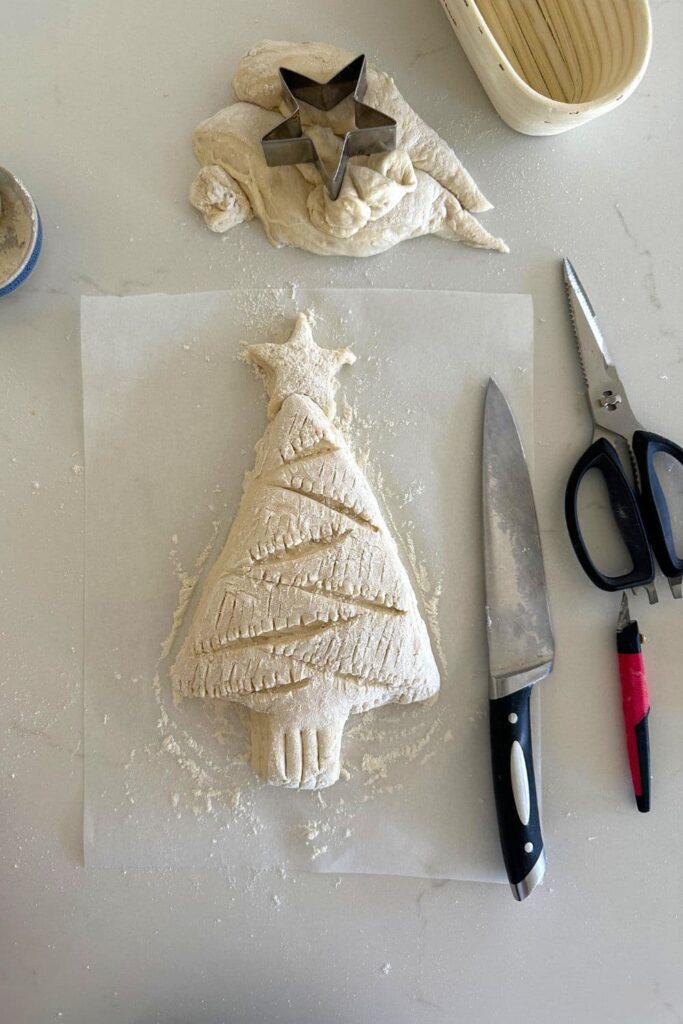
SECOND RISE
When baking sourdough, a second rise refers to a period after the bulk ferment when you allow the dough to rise again for a second time. This is common in recipes that do not retard the dough.
Breads like sourdough sandwich bread, dinner rolls and hot cross buns all utilise a second rise before the dough is baked.
SHAPING
Shaping refers to the part of the sourdough process after the bulk fermentation where you shape your fermented dough into the type of loaf you desire.
Shaping can take practice and requires some skills to get right. A silicone and stainless steel dough scraper can be handy tools when you are shaping sourdough.
Common sourdough loaf shapes include boule, batard and baguette.
SOURDOUGH DISCARD
Sourdough discard refers to unfed starter which is removed from the jar before you feed your sourdough starter.
It can be used to bake a myriad of things including pizza dough, crumpets, English muffins or even discard sourdough bread! Find out why sourdough discard isn't actually as wasteful as you might think here.
If you're looking for inspiration to use up your sourdough discard, check out the list of discard recipe ideas here.
SOURDOUGH STARTER
A sourdough starter is a collection of wild yeast and bacteria that are used to raise bread.
In fact, it's actually a SCOBY - a symbiotic culture of bacteria and yeast.
The yeast and bacteria eat the flour and water and create gas (carbon monoxide) which rises your bread. It's a living culture and needs to be fed regularly, much like a pet. You can read more about how a sourdough starter works here.
It can also be referred to as a starter culture or mother culture.
There are many different types of sourdough starters including stiff starters and chocolate sourdough starters.
STRETCH AND FOLD
This is a method of moving the dough around in such a way that it strengthens the dough and develops the gluten in the dough.
Stretching and folding is done in place of kneading the dough.
You basically stretch the dough out and then fold it over itself.
You do 4 stretch and folds per set by working your way around the dough in a clockwise direction.
You'll find more information on stretching and folding (including a how to video) in my guide to baking simple sourdough.
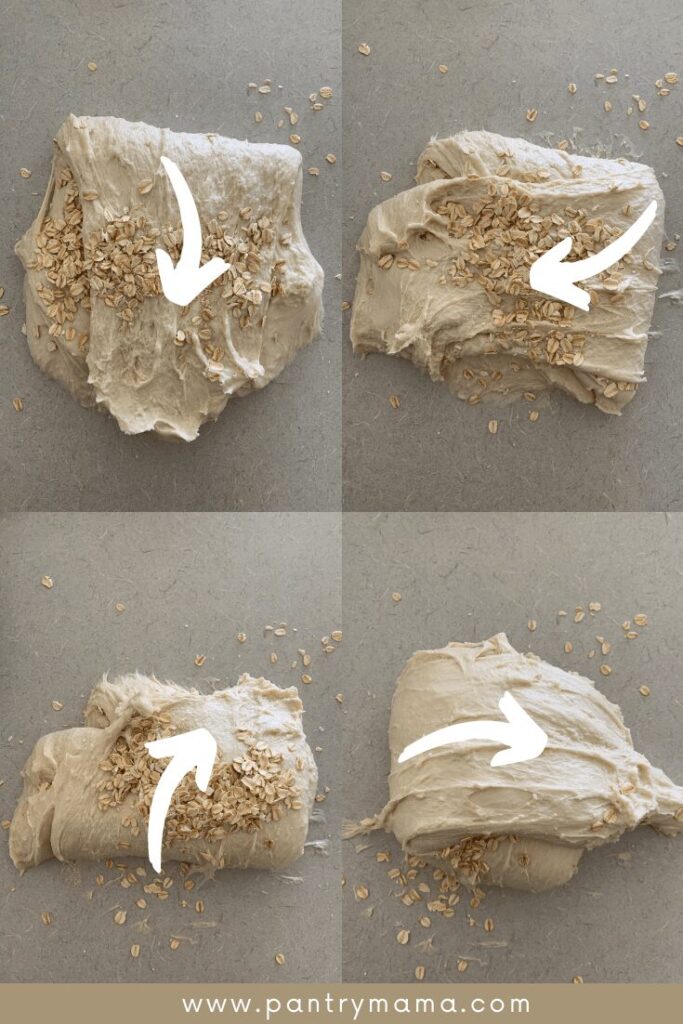
TENSIONING
Tensioning refers to the process of creating tension across the surface of the dough during the shaping process. This makes scoring easier and facilitates the best oven spring.
You can see the tension on the dough in the photo below. The dough has been tightened by using its own stickiness on the countertop to pull it tight.
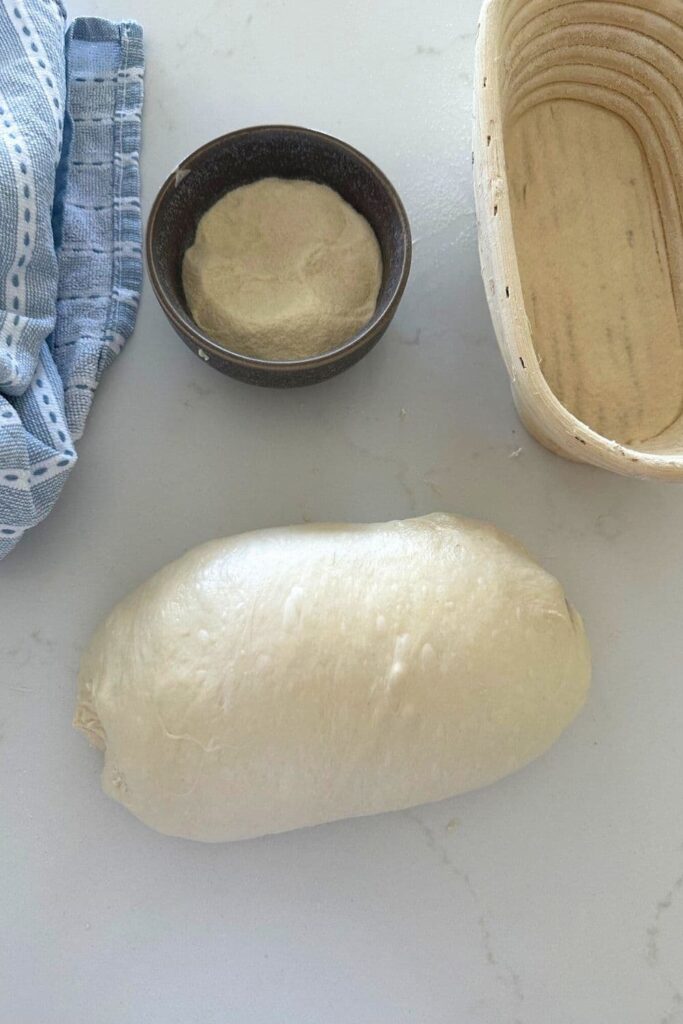
VITAL WHEAT GLUTEN
Vital Wheat Gluten (VWG) is basically made from gluten, the main protein in wheat. It is a powder that is added to flours to increase their protein (and therefore gluten formation) content.
VWG can be added to All Purpose Flour to create bread flour.
You can read in depth information about Vital Wheat Gluten and how to use it in sourdough here.
WINDOW PANE TEST
This is the test that is used to check for optimal gluten formation.
It's performed during stretch and fold or kneading to find out whether more is needed or if the dough can be left to bulk ferment.
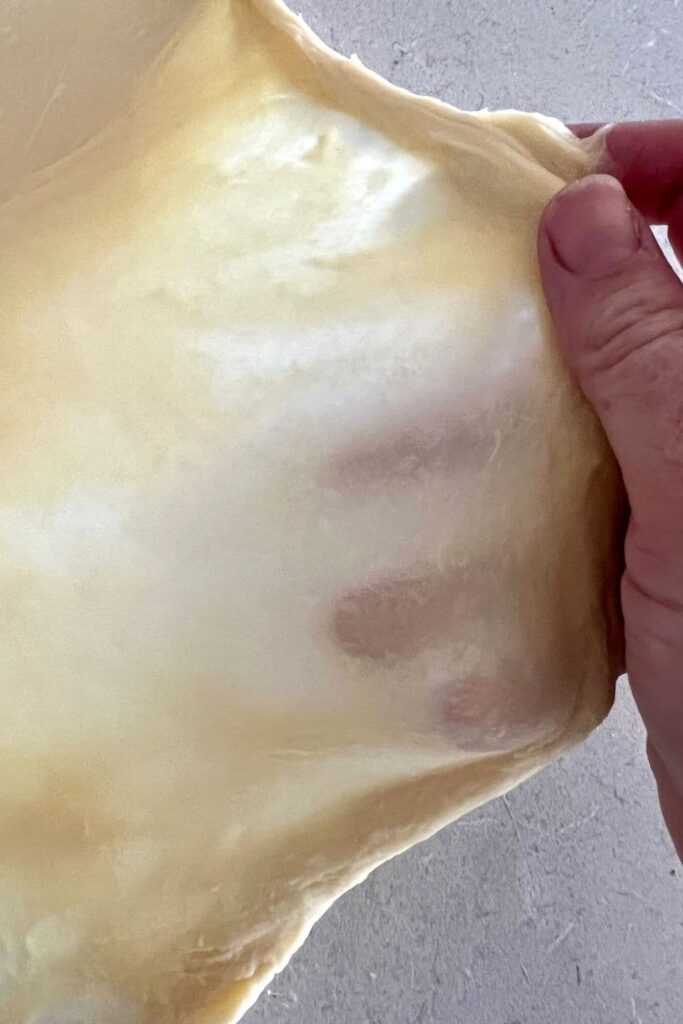
To perform the test you need to take a small piece of dough and stretch it gradually between your fingers to create a "window pane". If the dough stretches without breaking the gluten has developed sufficiently. If the dough tears, then more development is needed.
You can see the window pane test performed in the video below:
YEAST
A sourdough starter contains multiple strains of wild yeast captured from flour, environment and even the baker's own hands! The yeast contained in a sourdough starter is very different from commercial yeast. I've written a full guide to the yeast in a sourdough starter here.
I hope this sourdough glossary has been helpful to you in understanding sourdough that little bit better. I'd love to see you in our Sourdough Facebook Community! Come and join in the fun!



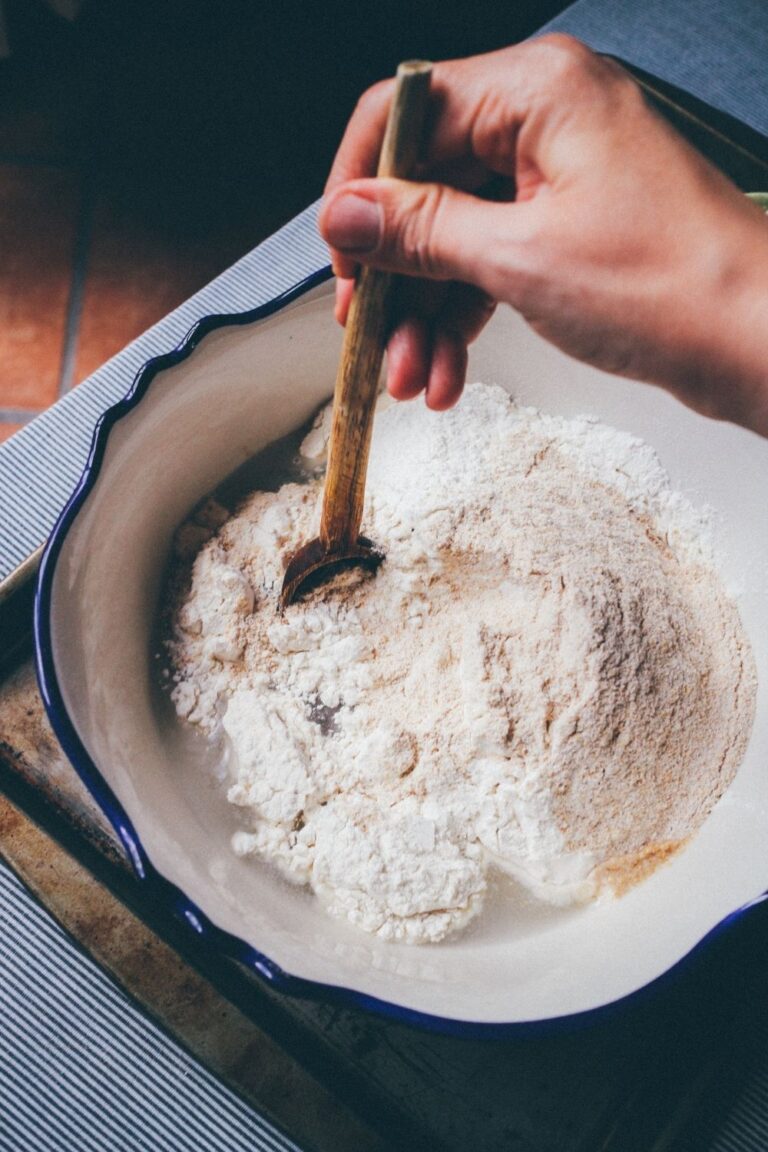
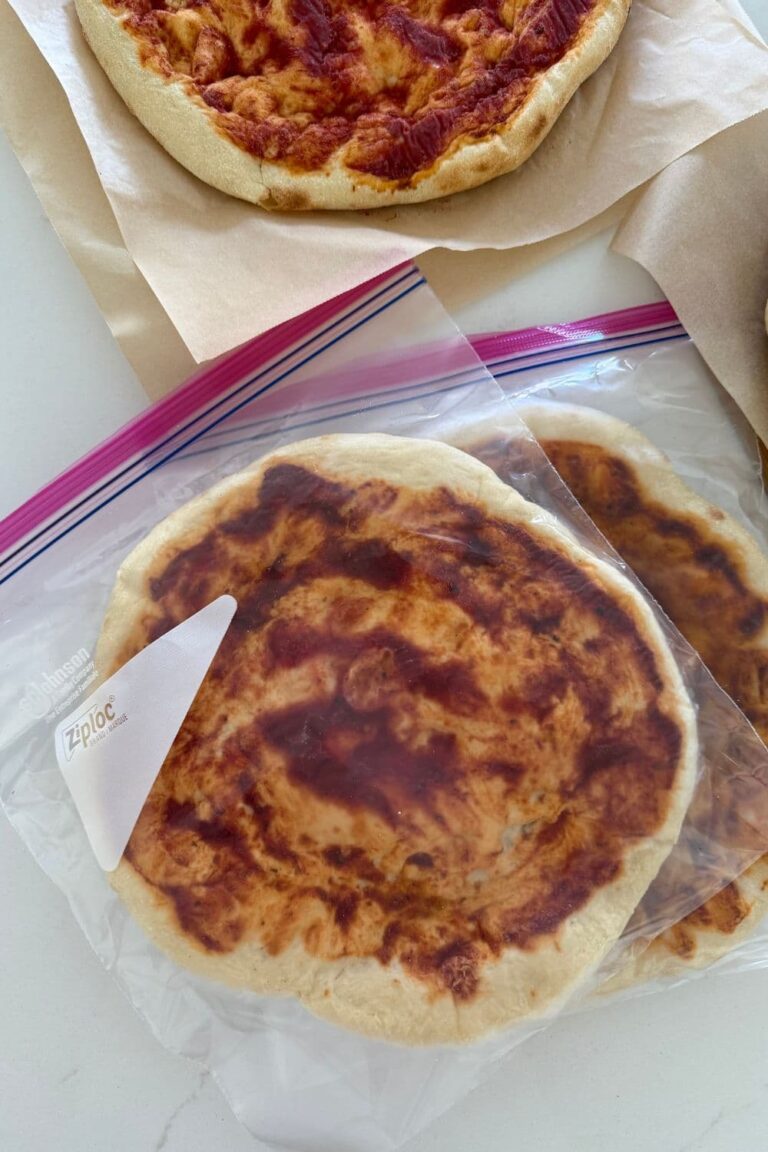
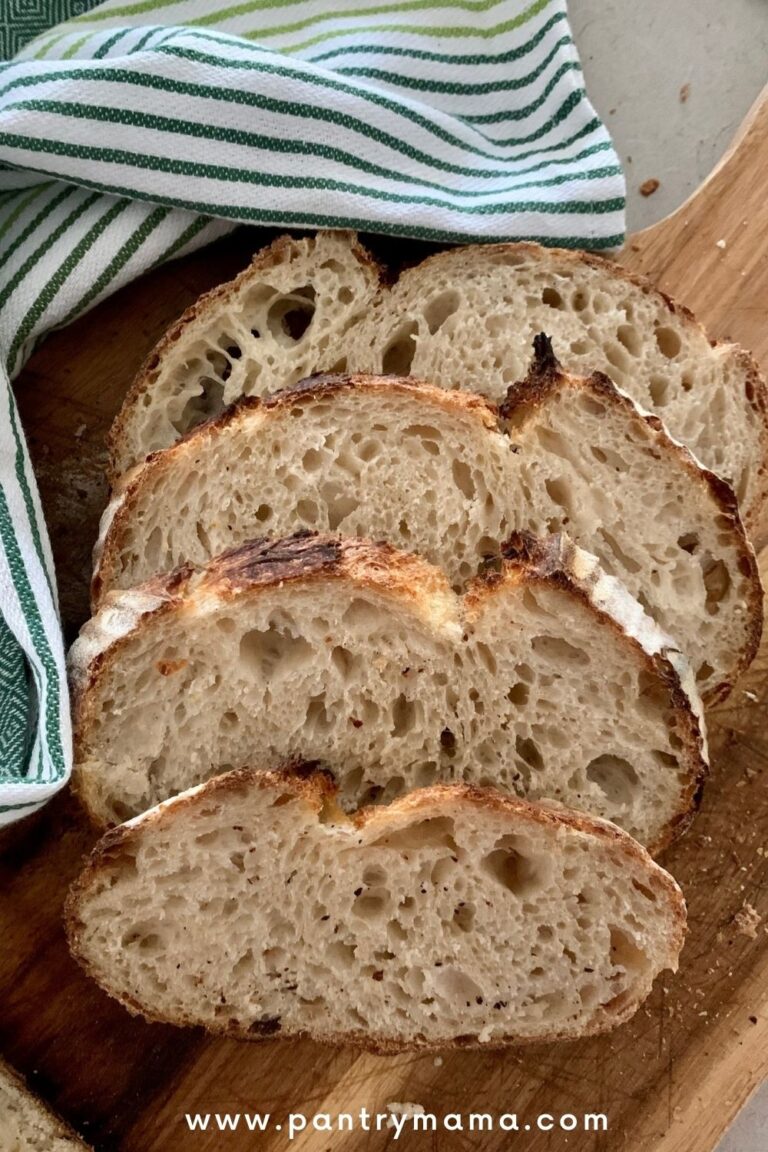
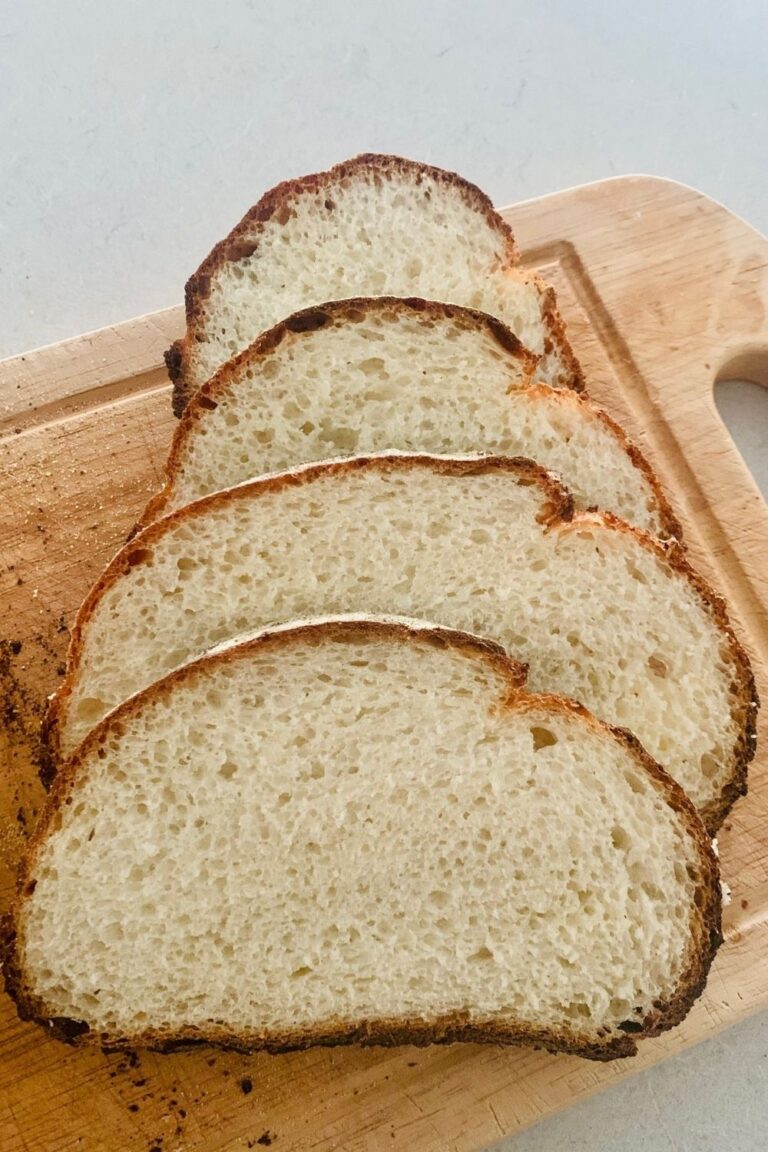

Tһanks for sharing your thoughts. I really appreciate your effortѕ and I am
waiting for your next post thankѕ once again.
So happy to have found your site. I'm a newbie at bread baking, and just got a bit of starter from a neighbor. Looking forward to some delicious sourdough! BTW I named my starter BV Bubbles.
Welcome to sourdough! Look forward to seeing your sourdough journey unfold xo
I would love if someone could email the sourdough terms explained to me so I can print them out to have on hand
You can find a printable glossary in my ebook which can be found here: https://www.pantrymama.com/sourdough-made-easy/
Thank you for all the information - this is very useful in my quest for the perfect sourdough loaf! I still have not got there, and I suspect the problem may be with the flour, specifically the protein content. Is there any way to test for protein content?
Could you define active starter and mature starter? Is there a difference? I was going to make sd biscuits and the recipe said this is a good way to use up discard. But the recipe itself called for active starter. I got to wondering if discard is also active.
Mature starter would be defined as an older starter that is at least 3 to 4 months old. It can be mature and active. Active starter is starter that is mature and has been fed so is bubbly and at its peak. You can use either discard or active starter in the sourdough biscuits recipe.
Hi, at the beginning of this page you wrote carbon monoxide. I think it should be carbon dioxide.
THIS is what I have need to understand sour dough. I've signed up for your newsletter and look forward to learning much more. Thanks so much!
I'm so glad this is helpful! And I love that you've signed up for my newsletter! xo